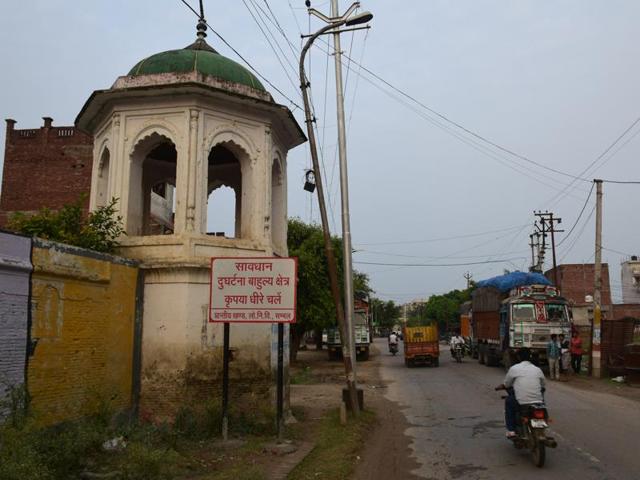Gaining infamy: How UP’s Sambhal got the terror tag
A small town in western Uttar Pradesh is under the scanner of security agencies after police traced six suspected members of the al Qaeda in Indian Subcontinent (AQIS) to a Muslim-majority locality.
A small town in western Uttar Pradesh is under the scanner of security agencies after police traced six suspected members of the al Qaeda in Indian Subcontinent (AQIS) to a Muslim-majority locality.

Police say AQIS chief Maulana Asim Umar alias Sanaul Haque – who is currently in Pakistan – hails from Sambhal, which has emerged as a possible new terror hub. Haque reportedly lived near the Roze Wali Masjid, a mere 200 metres from the houses of Mohammad Asif and Zafar Masood, who were arrested in 2015 for being alleged key AQIS operatives in India.
Three others — Syed Akhtar, 41, Sharjeel, 22 and Usman, 37 — are said to be in Pakistan. Investigators say Sambhal’s sizeable Muslim population and religious atmosphere may have played a part in fanning extremism – two factors in common with other suspected hubs such as Azamgarh and Bhatkal. Indian Mujahideen operative Yasin Bhatkal also chose towns with traits similar to Sambhal for recruitment and fund-raising, officials said.
“You could say Sambhal was the first perfect model the likes of Bhatkals looked for and cultivated,” says Shri Dhar Pathak, former inspector general of UP police.
The town – just 200 kilometres from Delhi — has a substantial number of expats in the West Asia, particularly Saudi Arabia, remitting huge amounts of cash. Ideologically driven, they make generous donations to seminaries. Haque, a student of the Deoband seminary, was among the five men from Sambhal and adjoining areas to have moved as a Harkat-ul-Mujahideen fighter to Pakistan in 1994, said an official of the UP-Anti Terror Squad. Haque studied at the Billaria Madarsa -- which produced the Taliban leadership -- before fighting in Afghanistan.
Sambhal’s tryst with notoriety began in 2000 when some local young men were picked up by police for their alleged role in an attack on the Red Fort in Delhi.
Two more men were arrested for alleged links with another terror module in 2001 but were cleared. Security sources said Sambhal and nearby Amroha were found connected with the Sankat Mochan temple blasts in Varanasi (2006). The UP-ATS says a Sambhal-Amroha-Bijnor-Saharanpur link was evident in 99% of the terror modules busted or pursued since 2007.
“I am not surprised at this discovery,” says Prakash Singh, former DG BSF. “Sambhal has always been notoriously communal. That is the understanding of the place I developed as DIG of Bareilly. Police have to think out of the box to prevent youngsters from falling under the influence of terror groups,” he said.
The town has seen prosperity in the last two decades.
“It used to be a backward place with a high rate of illiteracy but found wealth in exporting artwork on animal horns. These had a big market in West Asia,” said Dilip Trivedi, a former BSF director general who led the operation to bust the first terror module of the state in Aligarh in 1993.
That was around the time when a large number of people began flocking to west Asian countries for a better life.
Sambhal now has 40 seminaries. Ten of them are in Deepa Sarai where the alleged AQIS members come from.
“The ideological network in the region is strong. In this case, one can see many similarities with the IM modules cracked previously,” said a home ministry official.
But the people of Sambhal disprove the terror hub tag, calling the arrest of Asif and Zafar as part of a conspiracy to label the town as another Azamgarh. “My brother was a religious man. His children were his life,” said Asif’s brother Sadiq.
“Allah jaane how agencies linked him to al Qaeda. He didn’t even have the money to pay school fee of his kids. And where is the evidence of his travelling to Afghanistan and Pakistan for training?”
Shafiqur Rehman Barq, who represented Sambhal in the state assembly and Lok Sabha four times each, blamed the BJP for tarnishing the image of Sambhal and Muslims. “It was their (BJP) policy to weaken the unity of Muslims by implicating them in false cases and derive political benefits from the community’s state of confusion,” he said.
State minister and local MLA Nawab Iqbal Mehmood called it a conspiracy. But BJP’s district president Rajesh Singhal said instead of criticising the police, the minister should have demanded action against those involved in “terrorist activities”. Singhal said he would not allow Sambhal to become Kairana.
Get Current Updates on India News, Lok Sabha election 2024 live, Election 2024 along with Latest News and Top Headlines from India and around the world.



